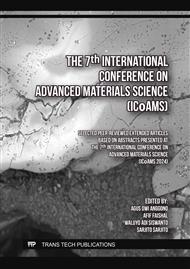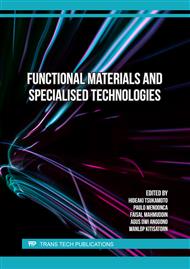[1]
M. Fitri and S. Mahzan, "The effect of fibre content, fibre size and alkali treatment to Charpy impact resistance of Oil Palm fibre reinforced composite material," IOP Conf. Ser. Mater. Sci. Eng., vol. 160, no. 1, 2016.
DOI: 10.1088/1757-899X/160/1/012030
Google Scholar
[2]
S. Mahzan, M. Fitri, and M. Zaleha, "UV radiation effect towards mechanical properties of Natural Fibre Reinforced Composite material: A Review," IOP Conf. Ser. Mater. Sci. Eng., vol. 165, p.12021, 2017.
DOI: 10.1088/1757-899x/165/1/012021
Google Scholar
[3]
C. A. Kakou, F. Z. Arrakhiz, A. Trokourey, R. Bouhfid, A. Qaiss, and D. Rodrigue, "Influence of coupling agent content on the properties of high density polyethylene composites reinforced with oil palm fibers," J. Mater., vol. 63, p.641–649, 2014, doi:10.1016/j.matdes. 2014.06.044.
DOI: 10.1016/j.matdes.2014.06.044
Google Scholar
[4]
M. Fitri and S. Mahzan, "The Regression Models of Impact Strength of Coir Coconut Fiber Reinforced Resin Matrix Composite Materials," Int. J. Adv. Technol. Mech. Mechatronics Mater., vol. 1, no. 1, p.32–38, 2020.
DOI: 10.37869/ijatec.v1i1.12
Google Scholar
[5]
M. Fitri and S. Mahzan, "Influence of coupling agent and fibre treatment to mechanical properties of oil palm fibre reinforced polymer matrix composite," J. Mech. Eng., vol. 5, no. Specialissue 4, p.223–232, 2018, [Online]. Available: https://jmeche.uitm.edu.my/wp-content/uploads/bsk-pdf-manager/15_SI_5_4_ID_160_379.pdf.
DOI: 10.1088/1757-899x/160/1/012030
Google Scholar
[6]
H. Pranoto and M. Fitri, "The Effect of Alkali Treatment to Mechanical Properties of Resin Composite Reinforced with Coir Coconut Fiber," vol. 19, no. 2, p.65–78, 2022.
DOI: 10.24191/jmeche.v19i2.19765
Google Scholar
[7]
D. Gay, Composite Materials Design and Applications, Third Edit. Boca Raton: CRC Press, 2015.
Google Scholar
[8]
S. Mahzan, M. Fitri, and M. Zaleha, "UV radiation effect towards mechanical properties of Natural Fibre Reinforced Composite material: A Review," J. Phys. Conf. Ser., vol. 755, no. 1, 2017.
DOI: 10.1088/1742-6596/755/1/011001
Google Scholar
[9]
D. W. Van Krevelen and K. Te Nijenhuis, Properties of polymer. Amsterdam: Elsevier, 2009.
Google Scholar
[10]
D. G. Goodwin et al., "Graphene/polymer nanocomposite degradation by ultraviolet light: The effects of graphene nanofillers and their potential for release," Polym. Degrad. Stab., vol. 182, 2020.
DOI: 10.1016/j.polymdegradstab.2020.109365
Google Scholar
[11]
E. Olewnik-Kruszkowska, I. Koter, J. Skopińska-Wis̈niewska, and J. Richert, "Degradation of polylactide composites under UV irradiation at 254 nm," J. Photochem. Photobiol. A Chem., vol. 311, p.144–153, Jul. 2015.
DOI: 10.1016/j.jphotochem.2015.06.029
Google Scholar
[12]
T. Lu, E. Solis-Ramos, Y. Yi, and M. Kumosa, "UV degradation model for polymers and polymer matrix composites," Polym. Degrad. Stab., vol. 154, p.203–210, 2018.
DOI: 10.1016/j.polymdegradstab.2018.06.004
Google Scholar
[13]
M. Torres, L. Burdin, A. V. Rentería-Rodríguez, and E. A. Franco-Urquiza, "Degradation of Epoxy–Particles Composites Exposed to UV and Gamma Radiation," Chem., vol. 5, no. 1, p.559–570, 2023.
DOI: 10.3390/chemistry5010040
Google Scholar
[14]
C. D. Varganici, L. Rosu, D. Rosu, I. Rosca, M. E. Ignat, and L. Ignat, "Surface Degradation of DGEBA Epoxy Resins Cured with Structurally Different Amine Hardeners: Effects of UV Radiation," Polymers (Basel)., vol. 16, no. 1, 2024.
DOI: 10.3390/polym16010067
Google Scholar
[15]
M. V. Podzorova, I. A. Varyan, N. V. Kiselev, Y. V. Tertyshnaya, and A. V. Khramkova, "Influence of UV irradiation on the degradation of composites based on polyethylene," E3S Web Conf., vol. 413, 2023.
DOI: 10.1051/e3sconf/202341302018
Google Scholar
[16]
M. Sit et al., "Inorganic Fillers and Their Effects on the Properties of Flax/PLA Composites after UV Degradation," Polymers (Basel)., vol. 15, no. 15, 2023.
DOI: 10.3390/polym15153221
Google Scholar
[17]
J. Tanks and K. Naito, "UV durability assessment of a thermoplastic epoxy-based hybrid composite rod for structural reinforcement and retrofitting," J. Build. Eng., vol. 48, 2022.
DOI: 10.1016/j.jobe.2021.103922
Google Scholar
[18]
R. V. Prakash and G. Sudha, "Degradation of Low-Density Polyethylene Film Exposed to UV Radiation in Four Environments," J. Hazardous, Toxic, Radioact. Waste, vol. 23, no. 4, p.4019015, Oct. 2019.
DOI: 10.1061/(ASCE)HZ.2153-5515.0000453
Google Scholar
[19]
A. Tor-Świątek and Ł. Garbacz, "UV Degradation Influence on the Selected Physical Properties of Extruded PVC/Ceramic Composites," Adv. Sci. Technol. Res. J., vol. 16, no. 3, p.282–294, 2022.
DOI: 10.12913/22998624/150400
Google Scholar
[20]
ASTM International, "Standard Practice for Operating Fluorescent Ultraviolet ( UV ) Lamp Apparatus for Exposure of Nonmetallic Materials 1," ASTM G154, 2014.
DOI: 10.1520/g0154-16
Google Scholar
[21]
International organization for standardization, "International Standard ISO 527-1:2012 Plastic-Determination of Tensile Properties," ISO 527-1, 2012.
Google Scholar
[22]
ASTM International, "Standard Practice for Fluorescent UV Exposure of Plastics 1," ASTM D4329, 2000.
Google Scholar
[23]
International organization for standardization, "Determination of changes in colour and variations in properties after exposure to daylight under glass, natural weathering or laboratory light sources," ISO 4582, 2007.
DOI: 10.3403/01467611
Google Scholar
[24]
ASTM, "G151-19 - Standard Practice for Exposing Nonmetallic Materials in Accelerated Test Devices that Use Laboratory Light Sources." p.15, 2010.
DOI: 10.1520/G0151-19
Google Scholar
[25]
ASTM international, "Standard Practice for Operating Fluorescent Light Apparatus for UV Exposure of," ASTM G154-06, 2011.
Google Scholar
[26]
E. Olewnik-Kruszkowska, I. Koter, J. Skopińska-Wiśniewska, and J. Richert, "Degradation of polylactide composites under UV irradiation at 254nm," J. Photochem. Photobiol. A Chem., vol. 311, p.144–153, 2015.
DOI: 10.1016/j.jphotochem.2015.06.029
Google Scholar
[27]
T. Lu, E. Solis-Ramos, Y. Yi, and M. Kumosa, "UV degradation model for polymers and polymer matrix composites," Polym. Degrad. Stab., vol. 154, no. August, p.203–210, 2018.
DOI: 10.1016/j.polymdegradstab.2018.06.004
Google Scholar



